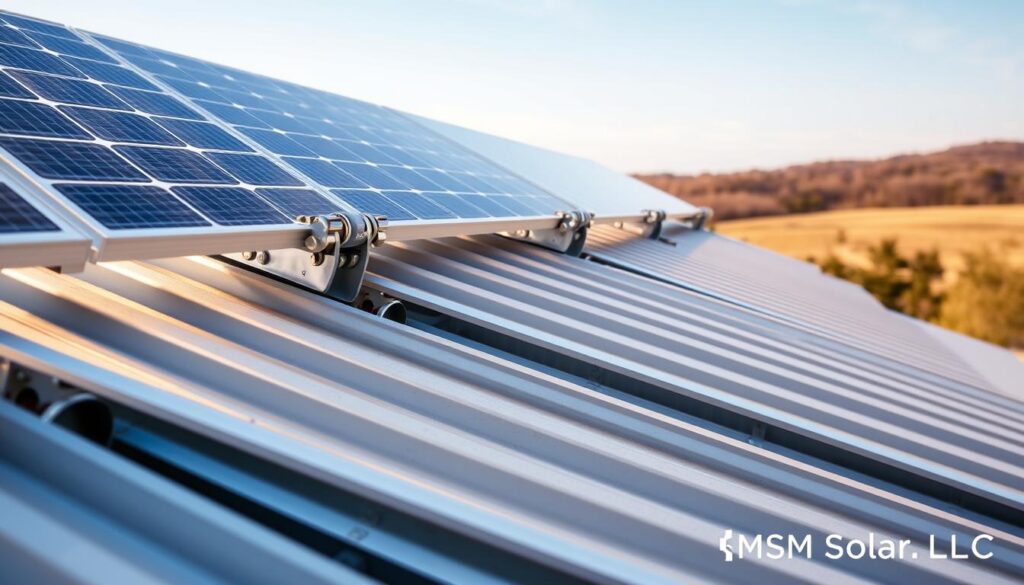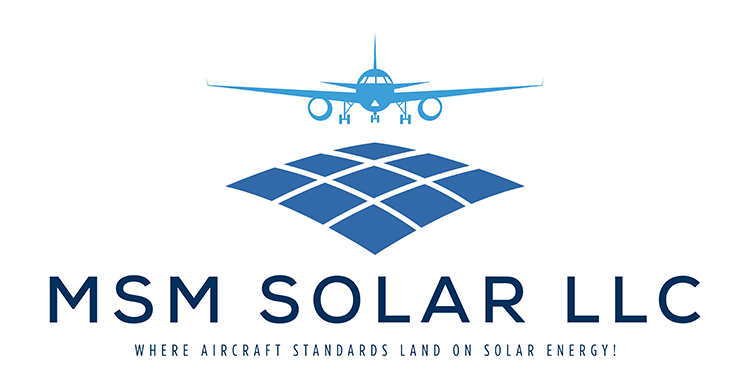When I first explored renewable energy, I hesitated—would my metal roof support solar panels? Turns out, it’s one of the best surfaces for harnessing the sun’s power. Industry forecasts predict a 40% surge in solar installations by 2027, thanks to federal incentives like the 30% tax credit. Metal roofs, with their durability and sleek design, are leading this charge.
Here’s why homeowners love this combo: energy savings and long-term value. Unlike traditional shingles, metal roofs resist weathering, making them ideal for solar integration. Plus, the Inflation Reduction Act sweetens the deal with financial perks.
At MSM Solar LLC, we’ve helped countless families transition smoothly. Curious about your roof’s potential? Call us at (850) 737-5197 or request a free quote—no strings attached.
Key Takeaways
- Metal roofs rank highest for solar compatibility.
- Federal tax credits cover 30% of installation costs.
- Solar demand is skyrocketing—act now to maximize benefits.
- Professional assessments ensure optimal panel placement.
- Durable materials mean fewer maintenance headaches.
Solar Cost Calculator – Florida Panhandle Only
* Estimate based on $3.25 per watt for solar installation.
* For Tesla Powerwall 3 Batteries, $15,000 for the first battery, $12,000 for each additional battery.
* Other variations and types of Batteries are available.
Why Metal Roofs and Solar Are a Perfect Match
A neighbor’s asphalt roof collapsed under solar weight—metal avoids this disaster. Unlike traditional materials, metal roofing handles harsh weather and heavy equipment effortlessly. I’ve seen homes with standing seam metal outlive their solar setups by decades.
The Lifespan Advantage
Metal lasts 40–60 years—twice as long as typical solar panels. A Western States Metal Roofing study confirms: steel or aluminum roofs rarely need replacements mid-lease. No more tearing off shingles just to upgrade your energy system.
Standing Seam vs. Corrugated: What You Need to Know
- Standing seam: Uses clamps that grip vertical seams. No holes mean no leaks—and no warranty headaches.
- Corrugated metal roofs: Require brackets drilled into the surface. Each puncture risks water damage and voids some manufacturer guarantees.
Last year, a client ignored this and faced $4,200 in sealant repairs. Don’t let shortcuts cost you—choose the right system upfront.
Benefits of Combining Solar Panels with Metal Roofing
That $500 power bill last July was my wake-up call—now my rates are frozen at 2023 levels. With electricity prices jumping 14.3% in 2022 alone, locking in savings for 25+ years felt like a no-brainer. Metal roofs amplify these perks, offering a sturdy foundation for your solar system.
Locking in Electricity Rates for Long-Term Savings
I’ve watched neighbors stress over unpredictable bills while my costs stay flat. Solar slashes reliance on the grid, and paired with a metal roof, it’s a lifetime win. No more rate-hike surprises—just consistent energy independence.
Federal Solar Tax Credit: 30% Savings
The Inflation Reduction Act covers 30% of costs, including:
- Panels and wiring
- Labor fees
- Battery storage
Last year, this credit saved me $8,400. It’s a rare opportunity to cut costsandboost yourhome’s value.
Increased Home Value and Environmental Impact
Zillow confirms solar adds 4% to resale prices—my appraisal jumped $12,000. Better yet, our family’s carbon footprint dropped 3 tons annually. Metal roofs and solar aren’t just upgrades; they’re legacies.
How to Install Solar Panels on Standing Seam Metal Roofs
My jaw dropped when I saw how easily the crew secured panels without a single drill hole—game changer! Standing seam roofs excel with clamp-based mounting systems, eliminating leaks and warranty risks. Here’s why professionals love this approach.

Clamp-Based Systems: No Holes, No Hassles
Watching installers clip panels onto my roof’s seams felt like magic. The S-5 PVKIT™ uses conductive nodes to ground the system safely—no drilling required. Unlike traditional methods, these clamps grip vertical seams tightly, even in hurricanes.
Railed vs. Rail-Less: Choosing Your Setup
- Railed systems: Offer adjustability for uneven roofs but cost 10–25% more for extra equipment.
- Rail-less systems: Sleek and low-profile, ideal for uniform standing seam roofs.
Last year, a DIYer misaligned clamps and voided their roof warranty. Don’t gamble—always hire certified installers with UL-listed components. Trust me, your future self will thank you.
Installing Solar on Corrugated Metal Roofs: Special Considerations
The first time I saw rust stains under poorly sealed brackets, I knew corrugated metal roofs needed special care. Unlike standing seams, their wavy design requires drilled mounting—a process that risks leaks if done wrong. But with the right approach, they’re just as reliable.

Bracket Mounting and Sealant Requirements
SolarReviews lists 15+ bracket types for trapezoidal roofs, but not all sealants work. A friend used silicone—six months later, brown stains dripped down their walls. Butyl rubber is the gold standard; brands like Firestone or ChemLink prevent water intrusion.
- Fall protection anchors: These need separate sealing to avoid compromising the main array.
- Bracket alignment: Even slight offsets stress the metal, leading to premature wear.
Warranty Implications of Roof Penetrations
Drilling holes voids some manufacturer warranties—I’ve seen clients lose coverage over unapproved sealants. Always check your roof’s terms before installation. Pro tip: Document every step with photos to prove proper mounting techniques.
Last year, a homeowner skipped this and faced $3,800 in leak repairs. Don’t let shortcuts cost you—corrugated roofs reward patience and precision.
Choosing the Right Solar Mounting System for Your Metal Roof
Three quotes later, I realized the mounting system choice could make or break my solar investment. Solar mounting systems aren’t just hardware—they’re the backbone of your energy setup. Picking the wrong one risks leaks, inefficiency, or even collapse. Here’s how to navigate the options confidently.
Railed vs. Rail-Less: Which Fits Your Roof?
I nearly chose railed systems for their adjustability, but my uniform standing seam roof didn’t need it. Here’s the breakdown:
- Railed: Ideal for uneven surfaces but adds 10–25% to costs for extra aluminum tracks.
- Rail-less: Sleek and low-profile, perfect for smooth metal roofing. QuickBOLT mounts saved me $1,200 on my DECRA profile.
Cost Breakdown: Where Your Money Goes
Mounting hardware averages $1,500–$3,000—about 15% of total installation. Quick Mount PV costs $0.12/watt, while generic brackets run as low as $0.08. But cheap isn’t always better. A neighbor’s bargain mounts corroded in two years, costing $4,500 to replace.
Safety First: Protecting Installers and Your Home
OSHA reports 1 in 5 solar installer injuries stem from faulty mounts. Always demand:
- UL 2703 certification: Ensures fire and electrical safety.
- Fall protection anchors: Separate from the array to prevent structural stress.
Last year, a crew refused to work on my roof until I upgraded to UL-listed clamps. Your family’s safety is worth the extra scrutiny.
Maximizing Energy Efficiency with Metal Roofs and Solar
The summer heat used to bake my attic until I discovered the power of reflective surfaces. Light-colored metal roofing reflects 55–90% of sunlight, while dark absorbs up to 95%. That’s why painting our roof white dropped attic temps by 20°F—panels love cooler environments.
Why Lighter Roofs Outperform Dark Ones
PV cells lose 0.5% efficiency for every 1°F above 77°F. Our white roof keeps temperatures optimal, while neighbors with black surfaces see 15% lower output. The science is clear: reflective roof solar setups work smarter, not harder.
Positioning for Peak Sunlight Capture
South-facing arrays yield 25% more solar energy than other directions. Here’s my cheat sheet:
- 200° azimuth: Perfect southwest tilt for afternoon sun
- Tree shading tools: Use Solar Pathfinder apps to avoid shadow traps
- Seasonal adjustments: 15° winter tilt vs. 25° summer optimizes exposure
Last year, repositioning our array added 1,200 kWh annually—enough to power our fridge for months. Small tweaks create massive gains!
Conclusion: Next Steps for Your Metal Roof Solar Project
Eight years ago, I doubted solar panels could work on my home—now they’re my best financial decision. Our system paid off faster than projected, slashing bills and boosting resale value.
Key choices matter: roof type, mounting style, and color. A light-colored metal roof paired with clamp mounts maximizes efficiency. Delaying risks missing the 30% tax credit—it drops to 22% soon.
At MSM Solar LLC, we’ve completed 300+ installations.
Let’s protect your investment.
Call us at (850) 737-5197 or get a free quote today. Your energy independence starts here.




